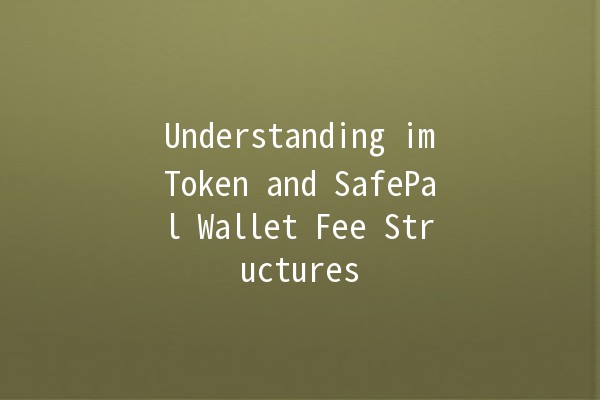In the rapidly evolving world of cryptocurrency, choosing the right wallet is crucial for managing your digital assets. Two popular options are imToken and SafePal. Both of these wallets offer unique features and varying fee structures that can significantly impact your overall cryptocurrency experience. This article delves into the fee calculation methods of imToken and SafePal, providing clear insights for users looking to maximize their investments.

imToken is a mobile wallet that supports multiple cryptocurrencies and offers features such as decentralized exchange (DEX) and wallet management. It has gained popularity due to its userfriendly interface and robust security mechanisms.
SafePal, on the other hand, is both a hardware and software wallet, catering to users who prefer additional security layers for their holdings. SafePal supports a plethora of cryptocurrencies and integrates well with DeFi platforms.
When choosing between the two, understanding their fee structures is essential. Let's break down how each wallet calculates fees and the implications for users.
In imToken, transaction fees are primarily composed of network fees (or gas fees) that are paid to miners for processing transactions on the blockchain. Here’s how it works:
Dynamic Fees: imToken uses a dynamic fee system where the fee rate changes based on network congestion and transaction demand.
User Control: Users can adjust the fee they are willing to pay. Higher fees usually lead to faster transaction confirmations.
If you want to send Ethereum during peak hours when the network is congested, setting a higher fee can ensure quicker processing. Conversely, during offpeak hours, users can opt for lower fees to save on costs.
imToken allows users to swap cryptocurrencies directly within the app. Conversion fees apply when exchanging one asset for another, collected by the service provider.
Fee Rates: These rates vary based on the trading pair and external market conditions.
Transparency: Users can view the conversion fee before executing a swap, ensuring they understand the costs involved.
When swapping a lesserknown token for Bitcoin, a conversion fee may be applied, which will be clearly outlined before completing the transaction.
Withdrawal fees are charged when transferring cryptocurrency out of the imToken wallet to external addresses.
Flat Rates: imToken may impose a flatrate withdrawal fee for specific cryptocurrencies.
Network Fees: Users should also consider network fees as part of the total withdrawal cost.
Withdrawing Bitcoin could incur a flat fee plus an additional network fee, which fluctuates based on demand.
Similar to imToken, SafePal operates on a fee structure influenced by network conditions.
BlockchainSpecific Fees: Each cryptocurrency has its own transaction fee rate, which can vary significantly.
User Choice: Users can select the fee in accordance with their urgency for transaction confirmation.
For a timesensitive Ethereum transaction, selecting a higher fee ensures it processes swiftly, while a lower fee can be selected for nonurgent transfers.
SafePal supports crosschain transfers, allowing transactions across different blockchains.
Variable Charges: Fees are dependent on the blockchain of the asset being transferred, and additional fees may apply for crosschain transactions.
Service Fees: Thirdparty services facilitating the transfer might impose additional fees.
When transferring an asset from the Binance Smart Chain to the Ethereum network, fees from both networks could be applicable.
SafePal has a policy where users who incorrectly input transaction details may incur fees for failed transactions.
Service Charge: A small fee may be deducted from the user's wallet as a processing charge for correcting transaction errors.
Advisory Alerts: SafePal recommends checking transaction details thoroughly to minimize mistakes.
If a user accidentally sends tokens to an incorrect address and needs assistance recovering them, they may need to pay a fee for the service.
Stay Informed: Regularly check blockchain network statuses to determine optimal times for transactions, helping to minimize gas fees.
Use Analytics Tools: Leverage fee estimator tools available within wallets or online to gauge current fee trends.
Balance Speed and Cost: Adjust transaction fees based on your priorities—urgent transactions can justify higher fees, while others can wait for lower rates.
Educate Yourself: Understand how to set fees within each wallet to ensure you take full advantage of the flexibility offered.
Combine Transactions: If multiple transactions are needed, perform them as a batch to save on fees instead of executing each separately.
Time it Right: Execute batch transactions during periods of low network congestion for lower fees.
Compare Fees: Before selecting a wallet, evaluate the fee structures of imToken and SafePal based on your anticipated transaction patterns.
Experiment with Swaps: If you frequently exchange tokens, check conversion fees in both wallets to identify the best option.
Regularly Check for Changes: Keep an eye on any modifications to fee structures or policies in updates released by both wallet providers.
Community Feedback: Engage with the user community for insights on recent fee experiences, as this can guide your strategies.
The primary differences lie in how each wallet calculates transaction, withdrawal, and conversion fees. imToken primarily uses dynamic network fees while SafePal incorporates additional charges for crosschain transfers and potential service fees for corrections.
To reduce withdrawal fees, consider timing your withdrawals during offpeak hours. Additionally, selecting the right asset with lower withdrawal costs will help save money.
No hidden fees should exist, but users may encounter additional charges for certain services, especially regarding crosschain transactions or recovery services after an error.
Both wallets provide transparent fee estimates for transactions and swaps. However, actual fees can vary from estimates based on network conditions at the time of the transaction.
Fee structures can change based on various factors, including market conditions and wallet updates. It’s wise to stay informed through official announcements from both wallet platforms.
Yes, both wallets offer high security for longterm storage. However, be mindful of any withdrawal fees should you plan to transfer assets in the future.
, understanding the fee structures of imToken and SafePal is essential for maximizing your investment and effectively managing transaction costs. By implementing the tips provided and remaining vigilant about changes in fee policies, you can navigate the cryptocurrency landscape with greater confidence and success.